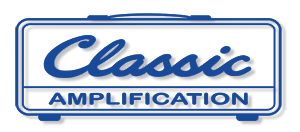
The earliest form of uni-vibes produced were sold under the Honey brand as a "Vibra Chorus". The Vibra Chorus was built with an internal speed control labeled "Repeat Time", it's mains fuse was on a bracket inside the box which was a hastle in you pop'ed a fuse and needed to replace it you had to dis-assemble the unit. It used the same circuit board, transformer, and other internal parts because it was indeed the same unit, built in the same shop, and likely the same people built them.

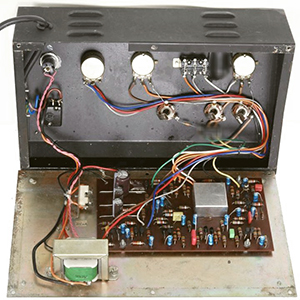
This Vibra Chorus has had a re-cap job done
Honey Catalog 1968


After the brand name Honey went away, the Vibra Chorus unit was re-named to Uni-Vibe a 5-pin DIN socked was added to the front panel for the use of an external "Foot Control" (speed/cancel pedal), the "Repeat Time" knob was replaced by a Fuse holder which was a good thing. This configuration is what most of us know as the Uni-Vibe.

Early production unit (light gray box)

Later production unit (dark gray box)
Fumio Mieda is historically credited for the design developed back in the mid 1960's. For years the popular belief was that the Uni-Vibe was originally intended as a rotating-speaker simulator (ie; Leslie), but in an interview done on Deepers View, Fumio states that it was actually intended to recreate the sound of radio stations (getting atmospheric modulation) that he listened to at night as a young man and was intrigued by the sounds.

As with many Japanese products of that time/era the Uni-Vibe was also re-branded for the export market, one such importer Lafayette Radio Electronics has the Uni-Vibe appearing as the Roto-Vibe in their 1969 catalog:

1969 Lafayette catalog #694
It was sold by Lafayette from 1969 to 1976 when it appeared one last time in their catalog as the Shiftee Uni-Vibe as Unicord/Univox was it's final handler. Notice the price only went up $5 in the 7 years it was offered by Lafayette.
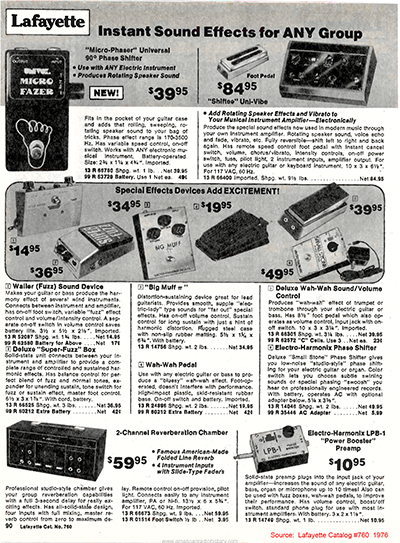
1976 Lafayette catalog #760
In it's final run of manufacturing and export for the Unicord/Univox brand, it was known as the Shiftee Uni-Vibe Model: U-915

Later Univox advertisement
How would you like to find this box at your local garage sale?
(car-boot sale)

brand new, in original box and cellophane wrapper, F'n WOW!
Here is a link to a reproduction of page-3 of a Unicord Owners Manual showing the original schematic for reference, notice it's a simple 13 transistor effect using a light bulb and some photocells.
(no OpAmps, IC's/Chips, JFET's)
The Honey Psychedelic Machine had a modified version of the Uni-Vibe circuit (with other things) but the vibe part of the circuit is much closer to the Phase Tone than a uni-vibe.

The Uni-Vibe also had a few cousins like the JAX Vibra-Chorus and Nomad Verberola similar internally to the Uni-Vibe but built with different phase caps and in the newer enclosure which also housed the Phase-Tone and Resley Tone...

JAX branded Vibra Chorus
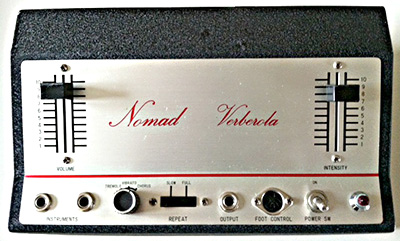
Nomad Verberola
The Phase Tone and Resley Tone were similar designs but with different LFO and phase-stage capacitors which gave them a different tone than the Uni-Vibe and Vibra Chorus...

Original (Shin-Ei) Phase Tone PT-18

Resley Tone RT-18 and Phase Tone PT-18 inside, it can be seen it's
very similar to a Uni-Vibe but not exactly the same circuitry
As was the thing back in those days, they too were re-branded and sold under other names:
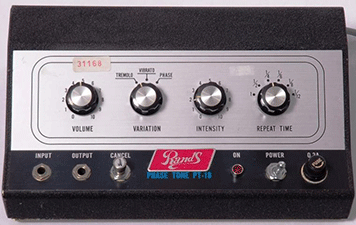
RandS re-branded Phase Tone PT-18

Garnet Phaser Tone, a re-branded Resley Tone RT-18
Jimi Hendrix song Machine Gun was a fine example of Uni-Vibe use, Robin Trower also made good use of the Uni-Vibe in songs like Bridge Of Sighs, Daydream*, and the second half of Too Rolling Stoned, while David Gilmour (Pink Floyd) used a Uni-Vibe in many songs such as Us And Them. All these are very fine examples of the unique Uni-Vibe tone we know and love.
*(producer Matthew Fisher added Uni-Vibe by re-amping Robin's track)
In this picture you can (just barely) see Jimi's Uni-Vibe on the floor behind him (lower right side of picture) in a recording studio:
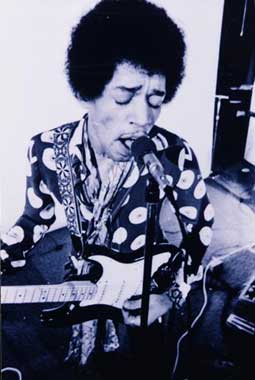
Jim Dunlop Sr of Dunlop Manufacturing fame holds the Uni-Vibe trademark which they aquired from KORG who had aquired the Univox/Unicord assets years earlier. The brilliant Jim Dunlop Sr passed on February 6, 2019 R.I.P.
BTW, just so we don't get off on the wrong foot here I'd like to say right up front that the following information is not a bash-fest on Dunlop as they (IMHO) are a fine company maintaining production of things that would have been lost in time had they not aquired them. Pedals like the venerable Cry Baby wah-wah and the MXR line are still here because of Jim Dunlop. I personally own and use a few Dunlop products myself as a guitar player and BTW I really like the Dunlop/Herco 75's and their 202 glass slides, and use a Cry Baby (which I've mod'ed to my own spec's).
Moving on, the following two pictures are the older Dunlop UV-1 and it's optional speed pedal, as you can see it goes by the trade name Uni-Vibe (new UV-2 seen further down the page), in this version of a Uni-Vibe Dunlop kept the two-piece layout making a box with an optional speed pedal although their design can run without the pedal like a hybrid of a Uni-Vibe/Vibra Chorus.


Dunlop UV-1 Uni-Vibe and optional UV-1FC foot controller.
The thing is, if you want a true original Uni-Vibe sound and you go buy a UV-1 (or the UV-2 released in 2014) Dunlop "Uni-Vibe" you are definately not going to get the original audio circuit, oh sure it has the right name and sounds very similar, but has a lot of additional parts not in the original circuit.
(foot controllers are not shown here)
The UV-1 is smaller than a vintage unit (which is good) and controls are similar enough and who could complain about that right?, it's when we open up the box for a look inside we clearly see there's a big difference from old-to-new.
These next few pictures show a side-by-side comparison of an original compared to a Dunlop Uni-Vibe UV-1:
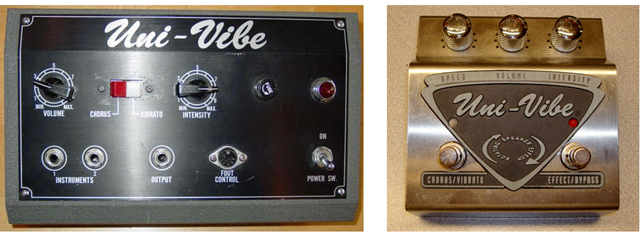
Original Uni-Vibe Dunlop UV-1 Uni-Vibe

Original Uni-Vibe Dunlop UV-1 Uni-Vibe

Original Uni-Vibe Dunlop UV-1 Uni-Vibe
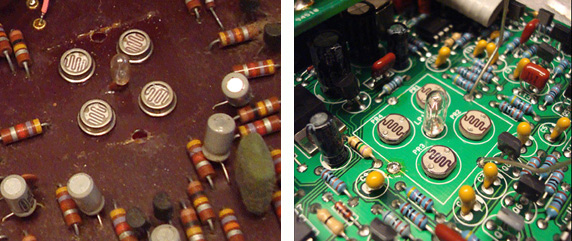
Original Uni-Vibe Dunlop UV-1 Uni-Vibe
The original Uni-Vibe was a simple 13 transistor circuit, it's simplicity is a major part of it's unique character, the Dunlop Uni-Vibe has load of IC (chips), JFETs, Buffers, Transistor arrays, Digital Logic Gates, etc, none of which were part of the original Uni-Vibe circuit. Most players in-the-know are aware that any extra components in the signal chain will effect the sound/tone and is the same reason why true-bypass is so popular these days, if it doesn't belong, get it out'ta there.
Note: for more about how IC chips can sound different than transistors click here.
This is the Dunlop UV-2 unit, it's got a new name UNIVIBE (as opposed to "Uni-Vibe") but hold-on, don't get too excited, this new vibe by Dunlop appears to be quite unlike an original Uni-Vibe:

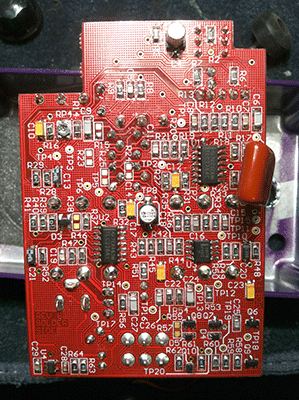



On their new Uni-Vibe UV2, Dunlop decided to go all FET (no lamp & photocells) it's built like their Phase90, well, what more can be said. They saw the writing on the wall with the impending international RHoS legislation taking place which is killing-off the production and import/export of Cadmium Sulfide based photo cells
Dunlop's latest version is not even trying to make an authentic Uni-Vibe anymore which is quite ironic as they are holding onto the tradename but not producing an original circuit. The new UV2 is more like a modified Phase90 than a Uni-Vibe.
Compare the pictures above with our Classic Vibe CV-2TM and Vibe-BabyTM (pictured below) both of which conform to the original vintage Uni-Vibe schematic all transistor and using photocells and lamp.
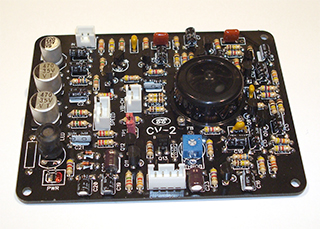
Classic-Vibe CV-2

Vibe Baby CV-2
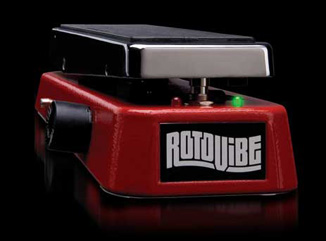
Some people think the Dunlop Roto Vibe is a Uni-Vibe built into a wah shell (like our Vibe-BabyTM pedal actually is) but that is not true. As noted above the original Roto-Vibe was indeed a Uni-Vibe unit sold under another name by Lafayette Radio Electronics.
I believe both trademarks (Uni-Vibe and Roto-Vibe) were obtained by Jim Dunlop in that KORG deal, bad move by Korg which is funny because in 2014 KORG came out with the Nuvibe with Fumio but couldn't use their once owned brand name Uni-Vibe.
Lets take a look under the hood of the Dunlop RotoVibe... wha'sup?, look what we find when we pop the back cover off:
Absolutely nothing like the original uni-vibe, the Dunlop Roto Vibe has only the name in common with the original Roto-Vibe circuitry:

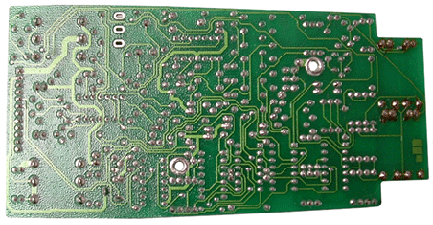
The Dunlop RotoVibe is built with plenty of IC's chips not part of the original Uni-Vibe/Roto-Vibe sound, and most notably it uses LED Opto-isolators instead of the Bulb/LDR setup.
(the bulb and photocells are a big part of what makes the Uni-Vibe sound unique).
The Dunlop RotoVibe is actually built much more like the 4-stage MXR Phase-100 than a real vintage Uni-Vibe.
Note: for more info on how IC chips can sound different than transistors click here.
Compare the Dunlop Roto Vibe circuit board with our Vibe-Baby CV-2TM circuit board below:


We do it all analog, all transistor, and
faithful to the original audio path!
If you want the best original Uni-Vibe sound in a pedal
Classic Vibe CV-2TM
-or-
Vibe-Baby CV-2TM
you'll really want a